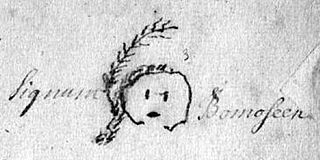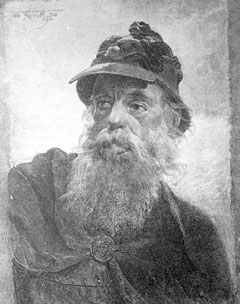Related Research Articles

Queen Anne's War (1702–1713) was the second in a series of French and Indian Wars fought in North America involving the colonial empires of Great Britain, France, and Spain; it took place during the reign of Anne, Queen of Great Britain. In the United States, it is regarded as a standalone conflict under this name. Elsewhere it is usually viewed as the American theater of the War of the Spanish Succession. It is also known as the Third Indian War. In France it was known as the Second Intercolonial War.

Penobscot Indian Island Reservation is an Indian reservation for the Penobscot Tribe of Maine, a federally recognized tribe of the Penobscot in Penobscot County, Maine, United States, near Old Town. The population was 758 at the 2020 census. The reservation extends for many miles alongside 15 towns and two unorganized territories in a thin string along the Penobscot River, from its base at Indian Island, near Old Town and Milford, northward to the vicinity of East Millinocket, almost entirely in Penobscot County. A small, uninhabited part of the reservation used as a game preserve and hunting and gathering ground is in South Aroostook, Aroostook County, by which it passes along its way northward.

King William's War was the North American theater of the Nine Years' War (1688–1697), also known as the War of the Grand Alliance or the War of the League of Augsburg. It was the first of six colonial wars fought between New France and New England along with their respective Native allies before France ceded its remaining mainland territories in North America east of the Mississippi River in 1763.
The Penobscot are an Indigenous people in North America from the Northeastern Woodlands region. They are organized as a federally recognized tribe in Maine and as a First Nations band government in the Atlantic provinces and Quebec.

Casco Bay is an inlet of the Gulf of Maine on the southern coast of Maine, New England, United States. Its easternmost approach is Cape Small and its westernmost approach is Two Lights in Cape Elizabeth. The city of Portland sits along its southern edge and the Port of Portland lies within.

Dummer's War (1722–1725) was a series of battles between the New England Colonies and the Wabanaki Confederacy, who were allied with New France. The eastern theater of the war was located primarily along the border between New England and Acadia in Maine, as well as in Nova Scotia; the western theater was located in northern Massachusetts and Vermont at the border between Canada and New England. During this time, Maine and Vermont were part of Massachusetts.
Treaty of Casco (1703) was an unsuccessful attempt made by Governor Joseph Dudley of Massachusetts Bay Colony to prevent further Indian hostilities from breaking out along the northern frontier. War was already going on in Europe between England and France and the eastern Indians were historically allies of New France, and had a close relationship with the French Jesuits.

Sébastien Rale (also Racle, Râle, Rasle, Rasles, and Sebastian Rale was a French Jesuit missionary and lexicographer who preached amongst the Abenaki and encouraged their resistance to British colonization during the early 18th century. This encouragement culminated in Dummer's War, where Rale was killed by a group of New England militiamen. Rale also worked on an Abenaki-French dictionary during his time in North America.

The Treaty of Portsmouth, signed on July 13, 1713, ended hostilities between Eastern Abenakis, a Native American tribe and First Nation and Algonquian-speaking people, with the British provinces of Massachusetts Bay and New Hampshire. The agreement renewed a treaty of 1693 the natives had made with Governor Sir William Phips, two in a series of attempts to establish peace between the Wabanaki Confederacy and colonists after Queen Anne's War.

The Wabanaki Confederacy is a North American First Nations and Native American confederation of four principal Eastern Algonquian nations: the Mi'kmaq, Maliseet (Wolastoqey), Passamaquoddy (Peskotomahkati) and Penobscot. The Western Abenaki are also considered members, being a loose identity for a number of allied tribal peoples such as the Sokoki, Cowasuck, Missiquoi, and Arsigantegok, among others.
Madockawando was a sachem of the Penobscot, an adopted son of Assaminasqua, whom he succeeded. He led the Penobscot on the side of the French against the English during King William's War.

Fort William Henry is located in the village of New Harbor in the town of Bristol, Maine. The fort was, in its time, the largest in New England. The fort was originally built in 1692 but destroyed four years later by New France in the Siege of Pemaquid (1696). A reconstruction was built in 1908. The fort was added to the National Register of Historic Places on December 1, 1969. Fort William Henry is now operated as a museum about the fort's history.

The siege of Pemaquid was a successful attack by a large band of Abenaki Indians on the English fort at Pemaquid, Fort Charles, then the easternmost outpost of colonial Massachusetts. The French-Abenaki attack was led by Jean-Vincent d'Abbadie de Saint-Castin and Father Louis-Pierre Thury and Chief Moxus. The fall of Pemaquid was a significant setback to the English. It pushed the frontier back to Casco (Falmouth), Maine.
The Northeast Coast campaign was the first major campaign by the French of Queen Anne's War in New England. Alexandre Leneuf de La Vallière de Beaubassin led 500 troops made up of French colonial forces and the Wabanaki Confederacy of Acadia. They attacked English settlements on the coast of present-day Maine between Wells and Casco Bay, burning more than 15 leagues of New England country and killing or capturing more than 150 people. The English colonists protected some of their settlements, but a number of others were destroyed and abandoned. Historian Samuel Drake reported that, "Maine had nearly received her death-blow" as a result of the campaign.

The Northeast Coast campaign (1745) occurred during King George's War from 19 July until 5 September 1745. Three weeks after the British Siege of Louisbourg (1745), the Wabanaki Confederacy of Acadia retaliated by attacking New England settlements along the coast of present-day Maine below the Kennebec River, the former border of Acadia. They attacked English settlements on the coast of present-day Maine between Berwick and St. Georges, within two months there were 11 raids - every town on the frontier had been attacked. Casco was the principal settlement.
The Battle of Falmouth was fought at Falmouth, Maine when the Canadiens and Wabanaki Confederacy attacked the English New Casco Fort. The battle was part of the Northeast Coast Campaign (1703) during Queen Anne's War.

The Northeast Coast campaign of 1746 was conducted by the Wabanaki Confederacy of Acadia against the New England settlements along the coast of present-day Maine below the Kennebec River, the former border of Acadia. During King George's War from July until September 1746, they attacked English settlements on the coast of present-day Maine between Berwick and St. Georges. Within two months there were 9 raids - every town on the frontier had been attacked. Casco was the principal settlement.
The Northeast Coast campaign of 1677 was conducted during the First Abenaki War and involved the Wabanaki Confederacy raiding colonial American settlements along the New England Colonies/Acadia border in present-day Maine. The Wabanaki killed and captured colonists and burned many farms, blunting the tide of colonial American expansion.
The First Abenaki War was fought along the New England/Acadia border primarily in present-day Maine. Richard Waldron and Charles Frost led the forces in the northern region, while Jean-Vincent d'Abbadie de Saint-Castin worked with the tribes that would make up the Wabanaki Confederacy. The natives engaged in annual campaigns against the English settlements in 1675, 1676, and 1677. Waldron sent forces so far north that he attacked the Mi'kmaq in Acadia.

Fort Casco was an English fort built in present-day Falmouth, Maine in 1698. It was the easternmost English fortification in New England and served as the boundary between English settlement and Wabanaki territory.
References
- ↑ Proceedings of the Massachusetts Historical Society, 13(1873–5):341; Jeremy Belknap, The History of New-Hampshire (Philadelphia: Robert Aitken, 1784), 1:158–9
- ↑ "Casco, Treaty of", by Jaime Ramon Olivares, in The Encyclopedia of North American Indian Wars, 1607–1890: A Political, Social, and Military History, ed. by Spencer Tucker (ABC-CLIO, 2011) p. 134
- ↑ "Settlement and Strife", Maine Historical Society
- ↑ Maine Historical Society, Maine History Online, "1668-1674: Settlement and Strife", p. 3 of 4, https://www.mainememory.net/sitebuilder/site/897/page/1308/display?page=3
- ↑ Story of Pemaquid
- ↑ Maine Historical Society, Maine History Online, "1668-1674: Settlement and Strife", p. 3 of 4, https://www.mainememory.net/sitebuilder/site/897/page/1308/display?page=3
- ↑ William Willis, The History of Portland(Portland, 1831), 2:6
- ↑ W.E. Daugherty, Treaties and Historical Research Centres, Research Branch, Corporate Policy, Department of Indian and Northern Affairs Canada, January 1983, https://www.aadnc-aandc.gc.ca/DAM/DAM-INTER-HQ/STAGING/texte-text/tremar_1100100028967_eng.pdf
- Dictionary of American History by James Truslow Adams, New York: Charles Scribner's Sons, 1940
- James Truslow Adams. Dictionary of American History. New York: Charles Scribner's Sons, 1940.
- The Story of Pemaquid – Treaty at Casco 1678